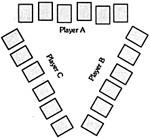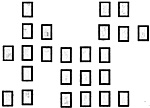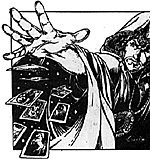Multi-player ST:CCG play (3 or 4 players) has been gaining in popularity and many people have submitted ideas to us for how best to do it. In this document I list some of the best suggestions we've received.
Please try them out, and let us know what you think! If you have some suggested refinements, or if you have completely different ways to play multiplayer, you are invited to send them in, and I will compile the best of them for inclusion in the next edition of this document.
Please send refinements or new sugqestions to DAnswerMan@aol.com and please use the title "ST:CCG Multi- Player Variants" in the Subject of the email.
Of course, I will try to qive credit to each person whose suggestion gets used (using your email name, or another form of credit of your choice). But please bear in mind that we get a lot of such suggestions and it isn't always easy to keep track or to tell what came first, etc., so don't flame me if I make a mistake! No compensation can be given for ideas submitted to this public forum other than recognition.
Notes on Converting Cards To Multiplayer Form
1) Multi-player games are recommended only for experienced players, because players will sometimes be required to remember who actually placed certain cards on the spaceline (such as Dilemmas).
In the standard game, the players lay down the cards always facing them so it is easy to remember, but here that often isn't possible. Note: If you have trouble remembering, several players report that Post-It Pad sheets (by 3M, available in any office supply store, small size) make good markers on cards, and do not damage the cards.
2) The wording on most cards works fine when used for multiplayer play. Some unclear situations can arise when the card refers to "the opponent." Sometimes this should be read as "all" your opponents (as when it is meant to affect everyone), and at other times it means you should choose a specific opponent for it to apply to. Usually this context is obvious. If it isn't obvious, apply it to the player on your left.
Cards can also be unclear if they refer to the spaceline, since the "shape" of the spaceline is not a "line" in most of these variations. But again it is usually obvious how to "translate" them to the new spaceline.
 VARIATION #1: "Triangle
and Square" Approach
VARIATION #1: "Triangle
and Square" Approach
3 or More Players
Suggested by: T2Thomas@aol.com and Voquih@netcom.com
This variation uses a spaceline in the shape of a triangle (3 players). The description here is for 3, but 4 works the same using a square setup, 5 with a pentagonal setup, 6 with a hexagon, etc.
Each player plays 6 mission cards to build a triangular "spaceline" that looks like at right:
Each player plays along his side of his own spaceline. Movement around to the other sides of the spaceline can be done in two ways:
- 1) Move from the "outside track"
on your side to the "inside tracks" of the
opponent's lines, or
2) The player who first suggested this variation says, "to get into someone else's line, you have to play a Where No One Has Gone Before on the appropriate intersection.
Or you can use wormholes (which we make "stable worrnholes" until Decipher makes an actual one) to get to someone else's space line.
After the wormholes are used, they stay where they are, allowing free use of them from there on.... with a house rule that along with the 60 card deck, each player must have 1 Where No One..., and 2 Wormholes for each player playing beyond the first, i.e. 2 Where No Ones and 4 Worrnholes for a 3 player game, etc.
"The games are a big success. I think that Multiplayer Star Trek is much more fun than regular two player and that the folks at Decipher should really consider making it official."
VARIATION #2: Using a Normal Spaceline
3 Players
It is possible to play using a normal spaceline. Several people have suggested variations on this theme, marking the cards in various ways, or using some restrictions to allow players to keep track of whose cards are where and who owns them.
Possibilities are as follows:
1) Play with each player handling a different affiliation (pre-selected). This helps the players keep track of card ownership by color alone in most cases. Non-aligned personnel are usually mixed with your affiliation and thus also tracked. Some memory work is required, however, especially if more than one person uses the same non-aligned ship; but it seems that experienced players can keep track.
2) An 18-card spaceline is built using 6 mission cards per player. (Can be any multiple of three really). Make a list of your own missions and dilemmas before start, to retrieve them later.
3) Two players sit on one side of the spaceline (side-by-side).
4) If one player's ship attacks another at a location, and the third player happens to have ships at the same location, the third player has the option of joining in the battle against either side.
5) Since players are restricted to one affiliation, Treaty cards are used differentiy. One suggestion made: "A treaty card prevents two players from attacking each other, but a second similar treaty card played by another player cancels the treaty (i.e.: both cards are discarded)."
The treaty can also be destroyed in other ways, of course.
 VARIATION #3: "Two
Dimensional Space" Token
System)
VARIATION #3: "Two
Dimensional Space" Token
System)
3+ Players
From: (This was our original multiplayer system designed with Darwin Bromley, which was not published in the rulebook).
It is possible to play with more than two players by doing the spaceline in two-dimensional form rather than as a "line". Actually, there are several ways to do this. The one we recommended was
1) Each player starts the game with a small supply of "tokens" (poker chips, etc.) of his own color. Mark a number on each token; making two tokens with "1", two "2", two "3", etc., as many as the number of ships you have in your deck.
2) During the "seed" phase of the game, instead of laying out the cards in a line, you place them adjacent to each other on any side (vertically as well as horizontally), growing a jumbled twodimensional space/time continuum that looks like something at right:
This is just an example; the fommation of mission cards that results could take almost any shape, somewhat like domino tiles in play.
3) Dilemma, Artifact, and Outposts are seeded undemeath the Missions as in the 2-player game.
4) Ship Movement--There is a pair of tokens for each players' ships to indicate the location of each ship on the space/time continuum. The ship cards (and the personnel and equipment cards aboard them), are played in front of the player, and placed beside one of the tokens.
The "mate" to that token with the same number is what you move around the space/time continuum to show where that ship is. Thus, all you have to move around is the token for the ship, placing it directly on top of the mission card where it is located.
Moving a ship is similar to the basic game, using the Range number of the ship and the Span number of the Mission card it wants to traverse. The difference here is that the ship can travel up or down as well as left or right (not diagonally), as far as the range of the ship will allow. The ship can also "sum" as it travels--moving one card left then two cards "up", for instance.
5) The rest of the game is played the same, interpreting where common sense says necessary for the different- shaped spaceline. (For example, Where No One Has Gone Before is used to go from one "corner" card to the opposite corner.)
Copyright Notice
 The information in this document is
copyrighted by Decipher Inc. 1995,
however, it can be freely disseminated
online or by traditional publishing means
as long as it is not altered and this
copynght notice is attached. © 1995
Paramount Pictures. All Rights Reserved.
STAR TREK: THE NEXT GENERATION
is a registered trademark of and all
characters and related marks are
trademarks of Paramount Pictures.
Decipher Inc. Authorized User.
The information in this document is
copyrighted by Decipher Inc. 1995,
however, it can be freely disseminated
online or by traditional publishing means
as long as it is not altered and this
copynght notice is attached. © 1995
Paramount Pictures. All Rights Reserved.
STAR TREK: THE NEXT GENERATION
is a registered trademark of and all
characters and related marks are
trademarks of Paramount Pictures.
Decipher Inc. Authorized User.
Related:
Back to Shadis Presents #18.5 Table of Contents
Back to Shadis Presents List of Issues
Back to MagWeb Master Magazine List
© Copyright 1995 by Alderac Entertainment Group
This article appears in MagWeb (Magazine Web) on the Internet World Wide Web.
Other military history articles and gaming articles are available at http://www.magweb.com